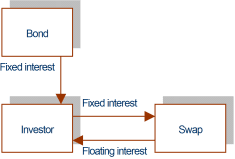
Barbican Consulting Limited
Asset Swaps
A measure of interest rate risk

What is an asset swap?
Asset swaps normally involve an investor buying a fixed coupon bond and at the same time entering into an interest rate swap that has a maturity equal to that of the bond.
The investor uses the coupon received from the bond to pay fixed interest on the swap. The swap counterparty then pays a floating rate of interest to the investor. The fixed rate investment has been converted into a synthetic floating rate note, (FRN), see the diagram below:

How does it work?
If the fixed interest the investor pays on the swap exceeds the current market swap rate then the floating interest rate payment received by the investor from the swap counterparty will be greater than Libor. (Normally this is expressed as Libor plus a number of basis points).
Why can the investor pay a relatively high rate on the swap? Because the bond coupons that are used to make the swap payments are higher than the swap rate.
This means that only bonds that have a yield or return that is greater than the swap rate will give the investor a return that exceeds Libor. Bonds that have a yield below the swap rate will provide returns beneath Libor.
Who does this and why?
Financial institutions are major investors in asset swaps. The assets can take the form of securities or loans. The main reason for creating the synthetic structure is to reduce interest rate risk. It also suits the funding profile of banks.
Banks fund themselves short term, it is cheaper. This means that the Libor receipt on the swap matches the short term funding cost. If the asset swap return is above Libor the bank will make a profit. It is this that attracts many buyers.
What is a par/par structure?
Par/par asset swaps are asset swap packages where the investor pays 100%, (par), for the bond and on maturity receives back 100%, (par). Suppose a bond trades at 99.50% including accrued interest, the investor pays 100% to the structuring bank. 99.50% is used for the bond purchase and 0.50% goes to the swap counterparty as an up-front payment.
The swap counterparty uses this 0.50% to increase the Libor margin paid to the investor over the life of the swap. The investor pays par and receives a return based on a par.
What are the advantages of asset swaps?
The main advantage for the investor is yield pick up; for investors who want to hold the asset to maturity the asset swap can offer an attractive return compared with similar vanilla floating rate notes and credit derivatives.
What are the disadvantages of asset swaps?
There are no free lunches. If the asset swap provides you with an attractive return it is because you are taking risk.
The main risk you will be taking is credit exposure on the bond. There is also a potential future credit exposure on the swap.
If you want to sell the asset swap before maturity the transaction costs of selling an illiquid bond and canceling the IRS can also be relatively high.
Finding bonds that offer attractive asset swap returns can be difficult. In as asset hungry market it has become difficult to find suitable investments. This is one of the reasons why credit default swaps and structured credit trades have become popular.
If the asset swap is placed in a banking portfolio and not marked-to-market the investor can end up holding a credit impaired asset without realising it.
How do you value an asset swap?
Marking-to-market the bond and the swap will not avoid credit risk but it will highlight any deterioration in the creditworthiness of the bond. The mark-to-market of the asset swap package comprises two items:
The market price of the bond.
The net present value of the associated swap.
Any change in value of the bond due to changing interest rates will be reflected by an equal and opposite change in the value of the swap. Any change in the credit spread of the bond will remain unhedged. If the credit spread of the bond improves there will be a net profit, if it deteriorates there will be a net loss.
First Published by Barbican Consulting Limited 2007